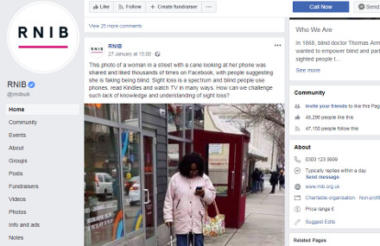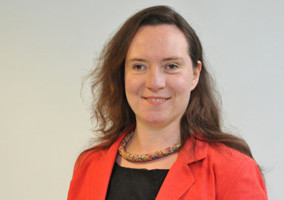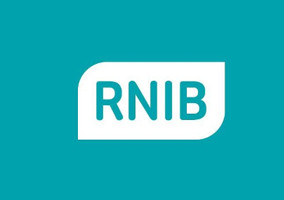Last week, a Facebook post featuring a picture of a woman on her phone while using a long white cane went viral. The written comment under the photo said, ‘If you can see what’s wrong say “I see it”.’
The post sparked hundreds of comments, full of speculation that the woman was faking her blindness and her need for a white cane.
At RNIB, we regularly hear from blind and partially sighted people that this is the kind of treatment that they experience in their daily lives. They tell us that when out in public, they feel judged, misunderstood and discriminated against. In the worst cases, people tell us they are yelled at and verbally abused.
And this can have a profound impact on people’s lives. It impacts on the confidence of blind and partially sighted people, it can prevent them from getting out and getting on with their everyday lives and can leave them feeling excluded from society.
Barriers to particpation
In the summer, we set out our new vision as a charity to ‘lead the creation of a world where there are no barriers for people with sight loss’. Following this we carried out research to find out what the biggest barriers blind and partially sighted people were facing to equal participation in society.
Overwhelmingly, people told us that it was the negative attitudes of others that was the biggest challenge they faced. This was followed by access to employment – in no small part due to the misconceptions of employers about what blind and partially sighted people can and can’t do. The lack of understanding, demonstrated by the reaction to the Facebook post, around how transformative an aide technology can be may also be key here.
So, transforming public attitudes is a central part of our new mission to smash the barriers to inclusion for blind and partially sighted people, but how are we going to do it?
Renewed focus
We began our renewed focus in this area with our rebrand in the autumn. As part of the launch of the new brand, we made a series of adverts and short films that used everyday scenarios and humour to challenge misconceptions that some of the general public have about people with sight loss.
These types of adverts and films will continue to play a central role in part of our long-term programme to transform public attitudes. They provide an accessible quick way to reach mass audiences with key messages. The use of humour helps to get cut through and provide connection with the issue.
The viral Facebook post provided us with an opportunity to use another key approach that we need to deploy if we are to be successful - calling out negative attitudes when we see them, supporting blind and partially sighted people to do the same, and using these opportunities to educate wider society and to make them think differently.
In this case, we issued a media comment, but also secured space for an opinion piece for our chair of trustees (who is herself blind), who points out that although the world has changed beyond recognition since RNIB was born 150 year ago, for blind and partially sighted people too much has stayed the same.
We also secured an opinion piece for a disability activist in national media, for them to explain the impact this type of thing can have. Chloe spoke articulately about how "this viral Facebook post was all my worst fears rolled into one. The fear of someone looking at me and thinking the whole thing was an act. The fear that the photo could quite easily have been me". This article is particularly important as it is vital that blind and partially sighted people’s voices are heard, and that they are given the opportunity to speak out directly and share their experiences to inform and educate the public.
Being community-led
Once the photo went viral we encouraged activists to tweet their own photos with the hashtag #BlindPeopleUsePhones, saying how they use theirs. We wanted this to be community-led, with our support, rather than RNIB-focused. Since then, the hashtag is being used by blind and partially sighted people in many countries, spreading awareness that that sight loss is a spectrum and doesn't always mean total blindness.
Being nimble and reactive to be able to call out and respond to these types of incidents is something that all charities must now do effectively, and the sector as a whole should be prepared to take some risks.
It is of course incredibly important that we try and ensure that we get the facts right about any incident before commenting. In a fast-moving social media environment, it can be easy to jump in to a debate without being fully aware of the facts. However, it’s clear that with the best will in the world we might still get things wrong and we’ll need to own that.
It’s also important that we find and promote the good stories as well as the bad. People often do or say the wrong thing through ignorance. If we can give them a ‘script’ or demonstrate what good looks like, we can genuinely start to break down that ignorance and promote inclusion.
Transforming public attitudes towards blind and partially sighted people is not a simple piece of work. Being ready and able to respond to emerging stories and conversations is just one tool in our toolbox but is an incredibly important one to get right.
RNIB’s vision of creating a world without barriers for people with sight loss is going to take efforts on multiple levels and a long-term programme of work, but a taking a vocal stand against exclusion, inequality and isolation is a good place to start.
|
Related articles












